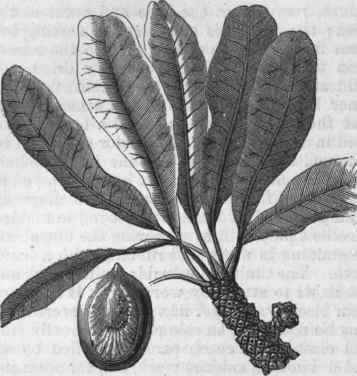Butter Tree
Description
This section is from "The American Cyclopaedia", by George Ripley And Charles A. Dana. Also available from Amazon: The New American Cyclopędia. 16 volumes complete..
Butter Tree
Butter Tree (bassia), a genus of the natural order sapotacece, found in India and Africa, the seeds of which yield a sweet buttery substance. The Indian butter, fulwa, ovphul-wara tree (B. butyracea) grows wild on the Almora hills in India, the trunk often measuring 50 ft. in height and 5 or 6 ft. in circumference, with broad oval leaves from 6 to 12 in. long, large pale yellow blossoms, and pulpy fruit about the size of a pigeon's egg, containing two or three roundish brown seeds. The fat expressed from the seeds is of the consistency of lard, is white, will keep for months, and is used as a substitute for animal butter, and medicinally for rheumatism and contractions of the limbs. The Indian oil or illupie tree (B. longifolia), similar to the preceding, grows in plantations on the S. coast of Ooro-mandel, and the fruit by pressure yields an oil used by the natives for soap, in cooking, and in their lamps. The wood is hard and valuable. The mahwa, madhaca, or madhooka tree (B. latifolia), native of the mountainous parts of Bengal, furnishes a hard tough wood; the flowers distilled afford a strong intoxicating liquor, and from the seeds is expressed a greenish-yellow oil used in lamps.
The shea tree, or African butter plant (B. Parkii), is not cultivated, but grows naturally in great abundance in the equatorial parts of Africa. The fruit resembles the Spanish olive, and from the kernel, dried in the sun and then boiled in water, is extracted a sweet, white, firm butter, which will keep for a year without salting. This is a very important article of African industry and inland trade.

Shea Tree (Bassia Parkii).
Continue to:


